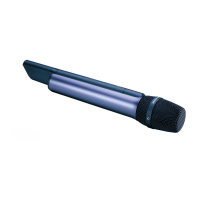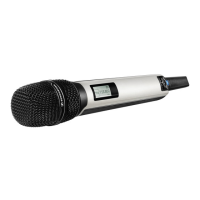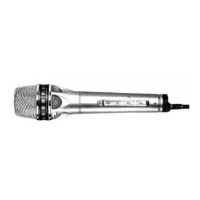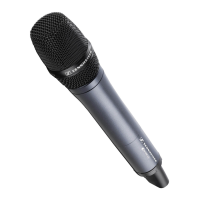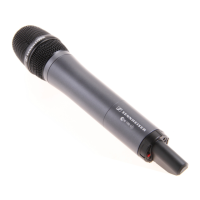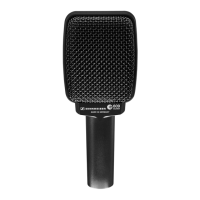Do you have a question about the Sennheiser SKM 500 and is the answer not in the manual?
Explains the six UHF frequency ranges and the structure of frequency banks and channels available.
Details the physical components and labeled parts of the radio microphone.
Explains the meaning of icons and indicators shown on the radio microphone display.
Step-by-step guide on how to insert power sources into the microphone.
Instructions for charging the rechargeable battery pack using the charging adapter and charger.
Procedure for unscrewing and replacing the microphone head.
How to remove and attach protective rings for identification and switch protection.
Instructions on how to power the radio microphone on and off.
Steps to temporarily disable the automatic lock mode for operation.
How to turn off the RF transmission for offline use or to prevent interference.
How to choose between different display views on the radio microphone.
Explains the function of each button on the radio microphone.
Presents the structure of the main and extended menus.
Describes how to navigate and interact with the menu system.
How to leave menu items and return to higher levels or the standard display.
Introduces the primary menu options like Sensitivity, Frequency Preset, Name, Auto Lock, Advanced, Exit.
How to set the audio input sensitivity to optimize sound levels and avoid distortion.
Guide to manually selecting frequency banks and channels for transmission.
How to assign a custom name to the radio microphone for identification.
How to enable or disable the lock mode to prevent accidental changes.
Overview of advanced settings like Tune, RF Power, Pilot Tone, etc.
Procedure for tuning frequencies and assigning them to channels in user banks.
Detailed steps to set a specific frequency for the active channel.
How to choose a bank, channel, and then assign a transmission frequency.
How to select between standard and low transmission power levels.
Steps to enable or disable the pilot tone signal for squelch and interference protection.
How to adjust the display contrast for better readability.
How to reset specific settings to factory defaults.
How to view the current firmware version of the radio microphone.
How to sync a single microphone with a receiver.
How to synchronize multiple microphones for multi-channel systems.
Advice on holding the microphone and adjusting sensitivity for best audio quality.
Tips on transmission range, line of sight, and antenna handling.
Guidance on using factory-preset frequencies and spacing transmitters.
Details on modulation, frequency ranges, switching bandwidth, and RF output power.
Information on compander system, frequency response, and signal-to-noise ratio.
Specifications for temperature range, power supply, dimensions, and weight.
Lists European compliance standards like EMC, Radio, and Safety directives.
Lists approvals from Canada and USA for radio frequency devices.
Technical data for different microphone heads, including type, sensitivity, and max SPL.
Visual representations of microphone pickup patterns and frequency response.
Illustrates the directional sensitivity of the MMK 965-1 microphone in cardioid mode.
Illustrates the directional sensitivity of the MMK 965-1 microphone in super-cardioid mode.
Graph showing the audio frequency response of the MMD 935-1 microphone.
Graph showing the audio frequency response of the MMD 945-1 microphone.
Graph showing the audio frequency response of the MMK 965-1 microphone in cardioid mode.
Graph showing the audio frequency response of the MMK 965-1 microphone in super-cardioid mode.
Details the product warranty period and conditions.
Lists compliance with RoHS, WEEE, and Battery Directives.
States conformity with R&TTE Directive and provides CE marking information.
Outlines FCC and Industry Canada compliance rules and user obligations.
| Modulation | Wideband FM |
|---|---|
| Battery Life | Up to 8 hours |
| Battery Type | 2 x AA batteries |
| Operating Temperature | -10 °C to +55 °C |
| THD | < 0.9 % |
| Input Sensitivity | 1.5 mV / Pa |
| Temperature Range | -10 °C to +55 °C |
| Compatibility | Sennheiser Evolution Wireless G3/G4 |
| Microphone Head | Interchangeable |
| RF Output Power | 10 mW / 30 mW / 50 mW |
| Connector | None (wireless) |
| Dimensions | Approx. 50 x 265 mm |
| Weight | Approx. 450 g (without batteries) |
| Peak Deviation | +/- 48 kHz |
| AF Frequency Response | 80 Hz - 18 kHz |
| Signal-to-Noise Ratio | > 110 dB |
